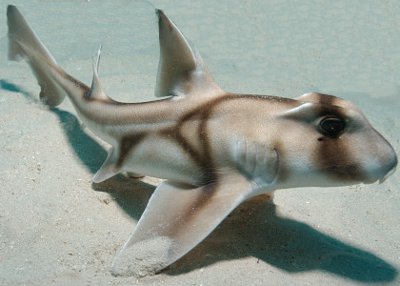Port Jackson Shark
Category: Shark

Facts about Port Jackson Shark, "Scientific name for Port Jackson Sharkis Heterodontus portusjacksoni". The Port Jackson Shark is nocturnal and oviparous also an egg laying shark. The Port Jackson Shark species belongs to the heterodontidae family. You will find the Port Jackson Shark in southern Australia in the coastal regions as well as in the waters off port Jackson hence its name. The Port Jackson Shark is light brown in color and it is about 5 feet 4 inches (1.67 meters) in length.
The Port Jackson Shark migrates unlike some sharks and it travels towards the south during summer. Port Jackson Shark returns north for purposes of breeding during winter. The Port Jackson Shark is known to feed on hard shelled mollusks, sea urchins, crustaceans as well as fish.
The Port Jackson Shark has a broad, flat head that is also blunt, an anal fin and crests above the eyes. The Port Jackson Shark is easy to identify due to the markings that run from the eyes down to the fin and across its entire body. These markings are harness-like and the teeth are also used to distinguish the Port Jackson Shark species from others in its family. The nostrils of the Port Jackson Shark species are connected to its mouth and their mouth is tiny making it easy to distinguish it from other sharks.
The Port Jackson Shark has two dorsal fins that are believed to be poisonous and they both appear similar in size. The front teeth of the Port Jackson Shark are small, sharp and pointed while their lower teeth are blunt and flat.
The male Port Jackson shark matures sexually at the age of 8-10 years while females mature at 11-14 years of age. Their breeding cycle is annual and it lasts from August all the way to November. During the breeding season the female Port Jackson shark will lay up to 8 pairs of eggs. The eggs then take ten to eleven months to mature after which the neonates are produced from the egg capsule.
The Port Jackson Shark species is not of much interest to man but for a few cases of scientific study where it is caught as bycatch. It is not also dangerous to mankind and is not also an endangered species.
There are over 400 types of sharks, Sharks have the most powerful jaws on on earth. Port Jackson Sharks jaws, both the upper and lower jaws move. Port Jackson Sharks skin is made of denticles instead of scales like other fish. The denticles are constructed like hard, sharp teeth (tooth-like projection) and this helps to protect the Port Jackson Shark from being injury. The Port Jackson Shark is carnivores meaning: an animal that feeds on flesh (Meat).

 Back To Category Shark
Back To Category Shark